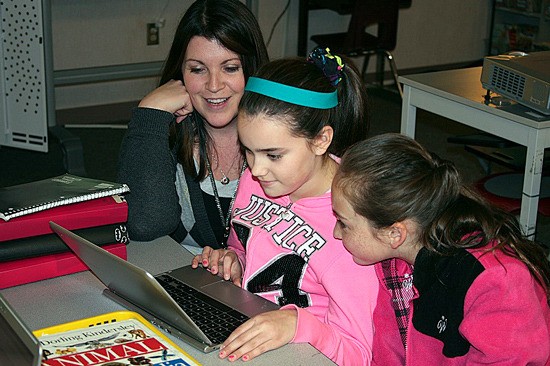The time for heavy textbooks and clunky computer carts may be coming to an end in the Sumner School District.
At the beginning of the 2016 school year, every student from the sixth grade and up will be receiving their own Chromebook to use at school and take home.
“Using the Chromebooks will allow students to have access to technology in order to be able to collaborate electronically and really have access to the tools that they need that they’ll be using in jobs in the future,” said Michelle Lewis, the district’s instructional services officer. “They’ll really have the opportunity to engage in an assignment where they will utilize 21st century skills.”
This “Chromebook initiative” began back in August 2013, when the district announced its three-year technology plan to put netbooks into the hands of students.
The money for the Chromebooks came from the voter-approved February 2014 Instructional Technology Improvements levy. The levy, which passed with 61 percent, authorized the district to collect $2.5 million in property taxes in 2015, $2.6 million in 2016, $2.85 million in 2017 and more than $3 million in 2018.
The district currently has around 7,500 Chromebooks spread around to all students from third to twelfth, and plans to purchase another 2,000 over the summer to be able to give every student from sixth grade on up a Chromebook of their own, said Kyal Olson, the district’s director of technology operations.
The district has started buying Chromebooks three years ago and the price has varied over the years, Lewis didn’t know how much the district has spend so far on the netbooks, but they both said the devices the district is buying now are cheaper than before.
“We’re talking about devices that are under $250. And textbooks, in some cases, exceed $200 apiece,” Lewis said. “There’s some financial incentive and cost savings in moving towards digital curriculum.”
If the Chromebooks averaged out to $250 a unit, the district has spent roughly $1.9 million on the netbooks.
Going digital
With the Chromebooks improving computer access to many students, the district is also starting to move some of their curriculum online.
“Next year, our English Language Arts curriculum – we will have some hard copies – but we will also have digital copies. And the great thing about the digital copies is that they have ‘additional dynamic content and features,'” Lewis said. “By that, I mean that there are articles and current events that are added to the content that students are reading about. The content is multi-media, so there will be things like videos.”
Lewis also said the district is using a new all-digital advisory curriculum called Career Cruising, which is meant to help students prepare for college and beyond.
Moving to digital curriculum also gives students universal access to resources, especially those who made have learning accommodations, Lewis said.
“Any student that would be in need of an accommodation by having text read aloud to them would have that available to them, any time and anywhere there is internet access,” said Lewis.
Shelf life and replacements
Just with textbooks, the Chromebook netbooks will eventually have to be upgraded and replaced as they age.
Olson said the district plans to replace the Chromebooks every four years, “Which is quite a long time for a device that is as inexpensive as a Chromebook is. We couldn’t be happier with the device that we chose.”
Olson said district’s tentative plan is to give incoming freshmen new Chromebooks to last throughout high school.
Student responsibility
When it comes to netbooks that are damaged or broken before it is needed to be replaced, Lewis said the responsibility falls mostly on the students.
“We will be treating the Chromebooks just like we treat a textbook,” she said. “There will be fines and fees levied for Chromebooks that are damaged or lost.”
Although the district can’t offer Chromebook insurance, Lewis said they can offer Chromebook assurance.
“Students who pay up front a certain amount of money, if something should happen to the Chromebook… some of the cost of the Chromebook would be covered,” said Lewis.
Lewis also said if families can’t afford to pay for a broken or damaged Chromebook, the district will handle that situation in the same way it would if a textbook had to be replaced.
And although students are able to take these Chromebooks out of the school setting and into their homes and abroad, the district isn’t worried much about them being stolen.
“Once the Chromebook has been reported lost or stolen, we would turn off all functionality,” Lewis said. “So, basically, the Chromebook would be useless.”


